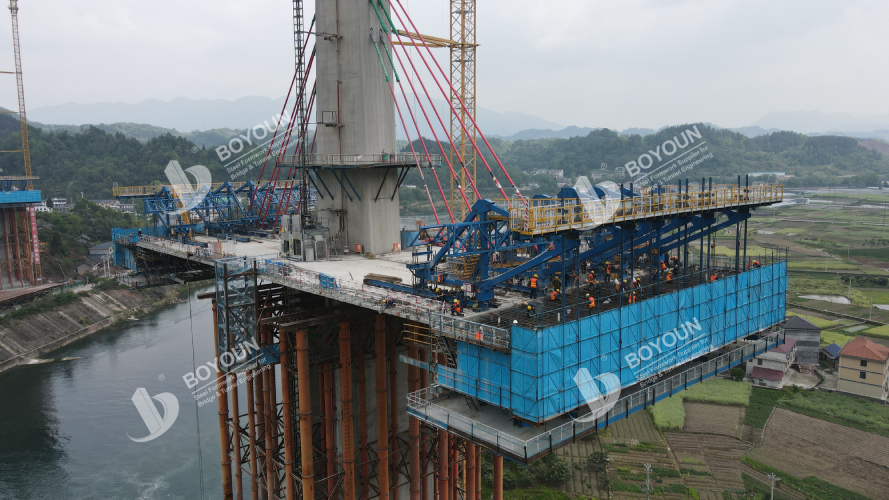This article comparatively analyzes the application conditions, pro and cons, and effect comparison of the cantilever casting construction method and the cast-in-place with scaffolding in bridge construction.Let's dive in!

The cantilever casting method involves constructing working platforms on both sides of the bridge pier, gradually casting concrete girder sections towards the midpoint of the bridge pier and applying tension.
The cantilever casting method is ideal for constructing high piers, long span bridges, rivers, and high-traffic routes with navigational and traffic needs. This applies to: (1) Deep and broad rivers and valleys. (2) Areas prone to flooding during construction. (3) Rivers with rapid currents are not suitable for waterborne operations. (4) Rivers with poor riverbed geology are unsuitable for constructing scaffolds. (5) Bridges with extremely tall piers. (6) When there are heavy traffic flows or structures under the bridge.
The cantilever casting system uses a cantilever form traveller on both sides of the pier columns, symmetrically to cast concrete in each girder section. After casting off one girder section, wait until the required strength is achieved, then tension and anchor the pre-stressed steel wire, and then move forward the form traveller, conduct the construction of the following girder section until the cantilever ends. Cantilever casting requires minimal construction sites, casting each section separately is easy to adjust and regulate the position of the girder section, and has good integrity. Weather conditions have relatively little impact on the construction, and each segment is continuous repetitive work that requires fewer construction personnel, technical expertise is easy to grasp, and operational efficiency is high. However, the girder part of the cantilever casting cannot be built parallel to the pier column, the construction process is long, and the concrete age of the cantilevered casting is short, resulting in significant effects of concrete shrinkage and creep.
The construction of continuously cast-in-place with scaffolding involves setting up temporary support piles and adding rebars section by section, constructing structural components layer by layer.
The cast-in-place with scaffolding is suitable for bridges without navigational or traffic requirements, with a pier height of 24 meters and favorable foundation conditions.
The cast-in-place with scaffolding must strictly control the quality of the brackets to ensure they meet national and industry standards. The foundation should be flat, sturdy, and not susceptible to flooding during the bracket erection process. The verticality of the erecting columns and horizontal and vertical hoist rods should be maintained during bracket erection to meet design and specification requirements, and the brackets should be torn down from top to bottom to ensure the stability of the uncovered parts. The pile launch method has a large and evenly distributed force area, requiring no large lifting or hoisting equipment. The girder part can be constructed parallel to the pier column, which will shorten the construction period. However, as the foundations must be of high quality, the limitations due to the height of the pier columns in the cast-in-place beam with scaffolding are substantial.
The primary safety risks associated with the suspended cantilever casting method include ensuring that the materials and fabrication of the cantilever form traveller meet field construction requirements, ensuring the secure control of crane lifting during suspension form traveller and formwork installation, and implementing safety controls against tipovers when moving the form traveller. Concerning the cast-in-place with scaffolding's safety controls: ensuring safe control of the level and bearing capacity after foundation treatment, securing the materials and carrying capacity of the support system. The chloride age of concrete for each beam section in the cantilever casting construction is shorter, which significantly affects concrete shrinkage and creep. The cast-in-place with scaffolding uses mass concrete pouring, which is highly influenced by temperature, the efficiency of concrete transportation, and the ability to pour efficiently with potential risks of insufficient vibration, cold joints, and quality issues caused by temperature differences in concrete shrinkage and inadequate maintenance.
During suspension casting, the longer the span, the longer the construction period. However, the relationship between the progress with cast-in-place with scaffolding and span is minimal, and the overall construction duration generally falls within two months. The cast-in-place with scaffolding has a significant advantage in terms of time compared to the cantilever casting method.
The cast-in-place with scaffolding places a high demand on the foundation and is only suitable for sites where the column height is not significant and there is a need for support systems. The cantilever casting construction is unaffected by terrain, geology, or pier conditions and has a wider range of applications. With the increase in span, the number of suspension casting stages increases, and the construction period extends progressively. The cast-in-place with scaffolding does not depend on the span, resulting in a shorter overall construction period compared to the cast-in-place with scaffolding method. In practical applications, appropriate construction methods should be selected according to specific conditions.

International Department: Room 2211-2212, Tower C of Wanda Plaza, Tongzhou District, Beijing 101118, China.
+86-13021287080
info@boyoun.cn